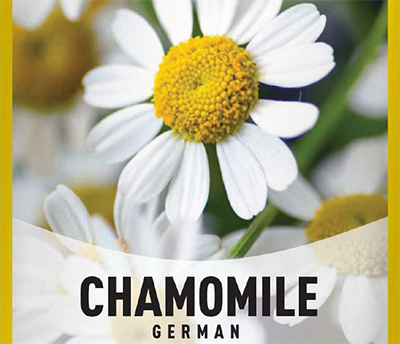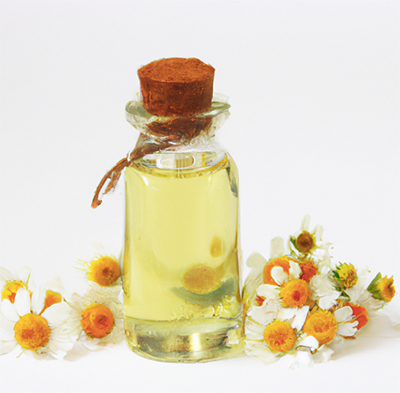Terpenes are a vast class of organic compounds produced by a variety of plants, particularly conifers, and by some insects. In cannabis, terpenes are responsible for the plant’s distinctive aromas and flavors. Over 100 different terpenes have been identified in cannabis, each contributing to the unique character of various strains. Among these, Bisabolol, also known as α-Bisabolol or Levomenol, stands out for its sweet, floral fragrance reminiscent of chamomile.
Read about different terpenes here: Myrcene, Pinene, Terpinolene, Linalool, Caryophyllene, Humulene & Camphene.
The Chemistry of Bisabolol
Bisabolol is a monocyclic sesquiterpene alcohol. This means it is a terpene with three isoprene units and contains a single ring in its structure, along with an alcohol group. Its molecular formula is C15H26O, and it has a molecular weight of 222.37 g/mol. The structure of Bisabolol includes a hydroxyl group (-OH) attached to the carbon chain, contributing to its classification as an alcohol.
Sources of Bisabolol
 While Bisabolol is present in cannabis, it is also found in a variety of other plants. The primary source is the essential oil of German chamomile (Matricaria chamomilla), where it can be found in high concentrations. It is also present in the candeia tree (Vanillosmopsis erythropappa) and other plants like the Brazilian tree, Myrocarpus fastigiatus. The presence of Bisabolol in these plants makes it a common ingredient in many essential oils used in aromatherapy and cosmetics.
While Bisabolol is present in cannabis, it is also found in a variety of other plants. The primary source is the essential oil of German chamomile (Matricaria chamomilla), where it can be found in high concentrations. It is also present in the candeia tree (Vanillosmopsis erythropappa) and other plants like the Brazilian tree, Myrocarpus fastigiatus. The presence of Bisabolol in these plants makes it a common ingredient in many essential oils used in aromatherapy and cosmetics.
Sensory Profile
Bisabolol is highly regarded for its pleasant aroma. It has a sweet, floral scent with hints of spice and citrus. This delicate fragrance is one reason Bisabolol is favored in the perfume industry. In cannabis, the presence of Bisabolol can enhance the overall sensory experience, adding layers of complexity to the aroma profile of different strains.
Role in the Plant
In cannabis and other plants, terpenes like Bisabolol play several critical roles. They act as a defense mechanism against herbivores and pathogens, attract pollinators, and protect the plant from environmental stressors. The specific role of Bisabolol in cannabis is not fully understood, but it is believed to contribute to the plant’s resilience and overall health.
Extraction and Isolation
 Extracting Bisabolol from plants involves processes like steam distillation or solvent extraction. In the case of cannabis, the extraction process can be more complex due to the presence of numerous other compounds. Advanced techniques such as supercritical CO2 extraction are often used to isolate Bisabolol and other terpenes from the plant material. Once extracted, Bisabolol can be further purified for use in various applications.
Extracting Bisabolol from plants involves processes like steam distillation or solvent extraction. In the case of cannabis, the extraction process can be more complex due to the presence of numerous other compounds. Advanced techniques such as supercritical CO2 extraction are often used to isolate Bisabolol and other terpenes from the plant material. Once extracted, Bisabolol can be further purified for use in various applications.
Industrial and Commercial Uses
Perfumery and Cosmetics
One of the primary uses of Bisabolol is in the fragrance industry. Its sweet, floral scent makes it a valuable ingredient in perfumes, lotions, and other personal care products. Bisabolol’s mildness and pleasant aroma make it ideal for formulations intended for sensitive skin.
Food and Beverages
In the food industry, Bisabolol is used as a flavoring agent. Its subtle floral and citrus notes can enhance the taste of various food products and beverages. While it is used sparingly, its impact on the flavor profile can be significant, adding a unique and appealing nuance.
Aromatherapy
Bisabolol’s presence in essential oils, particularly chamomile oil, makes it a popular choice in aromatherapy. Its calming and soothing scent is believed to promote relaxation and well-being. Aromatherapy products containing Bisabolol are often used in diffusers, massage oils, and bath products.
Cannabis Strains Rich in Bisabolol
Several cannabis strains are known for their high Bisabolol content. These strains are often sought after for their unique aromatic profiles and the potential enhancement they bring to the overall experience. Some notable strains include:
- ACDC: A balanced hybrid strain known for its high CBD content and low THC levels. It has a sweet, earthy aroma with floral undertones attributed to Bisabolol.
- Harle-Tsu: Another high-CBD strain, Harle-Tsu is prized for its relaxing effects and pleasant aroma. The presence of Bisabolol adds a layer of floral sweetness to its scent profile.
- Pink Kush: An indica-dominant strain with a sweet, vanilla-like aroma. Bisabolol contributes to its complex bouquet of scents, which includes floral and earthy notes.
- OG Shark: A potent strain with a unique blend of sweet and skunky aromas. The Bisabolol in OG Shark enhances its floral and spicy fragrance.
Cultivation and Genetics
 The presence of Bisabolol in cannabis is influenced by both genetics and cultivation methods. Breeders often select for terpene profiles when developing new strains, aiming to enhance desirable characteristics like aroma and flavor. Environmental factors such as soil quality, light exposure, and nutrient availability also play a role in terpene production. Growers who focus on optimizing these conditions can influence the levels of Bisabolol and other terpenes in their plants.
The presence of Bisabolol in cannabis is influenced by both genetics and cultivation methods. Breeders often select for terpene profiles when developing new strains, aiming to enhance desirable characteristics like aroma and flavor. Environmental factors such as soil quality, light exposure, and nutrient availability also play a role in terpene production. Growers who focus on optimizing these conditions can influence the levels of Bisabolol and other terpenes in their plants.
Terpene Interactions
Terpenes in cannabis do not work in isolation. They interact with each other, as well as with cannabinoids like THC and CBD, to create a phenomenon known as the entourage effect. This concept suggests that the combined effect of all the compounds in cannabis is greater than the sum of their individual effects. While Bisabolol’s specific interactions are still being studied, its presence in various strains contributes to the overall complexity and depth of the cannabis experience.
Future Research and Trends
The study of terpenes, including Bisabolol, is an evolving field. As interest in cannabis and its components grows, more research is being conducted to understand the full range of their properties and applications. Advances in extraction techniques, analytical methods, and breeding practices are likely to enhance our knowledge of Bisabolol and its role in cannabis and other plants.
Conclusion
Bisabolol is a fascinating terpene that adds a sweet, floral dimension to the aromatic profile of cannabis and other plants. Its presence in essential oils, perfumes, cosmetics, and food products highlights its versatility and appeal. As research continues to uncover the complexities of terpenes, Bisabolol remains a key player in the intricate and aromatic world of cannabis. Whether enhancing the fragrance of a cannabis strain or adding a soothing note to a cosmetic product, Bisabolol’s unique characteristics make it a valuable and intriguing compound.

